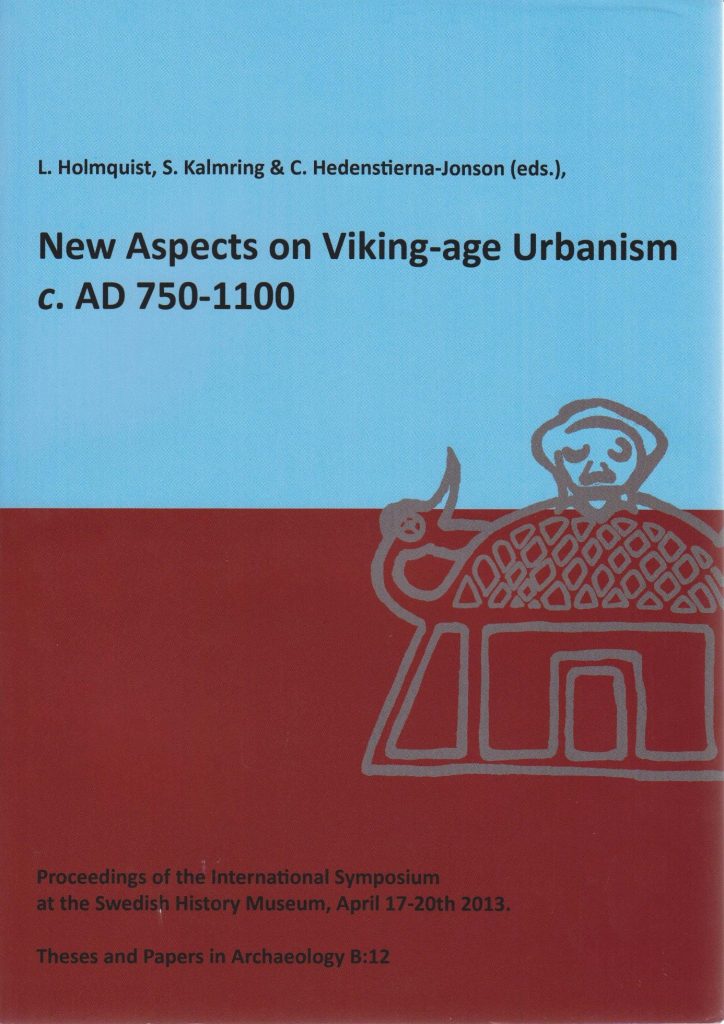New aspects on Viking-age urbanism c. AD 750–1100
Lena Holmquist, Sven Kalmring, & Charlotte Hedenstierna-Jonson (eds.): New aspects on Viking-age urbanism c. AD 750-1100: Proceedings of the International Symposium at the Swedish History Museum, April 17–20th 2013. Theses and papers in archaeology B:12. Archaeological Research Laboratory, Stockholm University (Stockholm 2016)
The volume “New Aspects of Viking-age Urbanism, c. AD 750-1100”, published in the series Theses and Papers in Archaeology of the Archaeological Research Laboratory at Stockholm university, gathers the proceedings of the eponymous conference held at the Historiska museet in Stockholm in 2013.

The idea to a joint conference arose from the need for a contemporary comparison between the Viking-age sites of Birka and Hedeby in a larger context. Hereby, such an attempt to relate and compare just these two sites is not novel at all: As early as in 1926 Sune Lindqvist pointed to the close connections between the two maritime trading centres in his article “Hedeby och Birka“, published in the periodical Fornvännen. In 1941 Herbert Jankuhn still penned an article on “Birka und Haithabu” in the Ahnenerbe-periodical Germanien on the sites’ different nature in trade. Thereafter, and essentially until now, the long shadow of World War II had put an end to any further efforts.
The aim of the conference was particularly the discussion of structural aspects of Viking age urbanism at two specific regions in lake Mälaren in Eastern Sweden and at the Schlei fjord at the margin between the North and Continental Europe. The problem of Viking age urbanism has not yet found a simple explanation and, while more recent attempts tend to tackle the problem via connectivity and network theory, even rather aged theoretical models by renown authors such as e.g. H. Pirenne, K. Polanyi or W. Christaller are still being influential. However, due to modern field research important progress has been made regarding questions of structural details, creating a new basis for the aspired discussion.
In order to assure the thematic frame of the conference colleagues were directly requested and asked to give a paper on predefined topics according to the problem. The symposium itself was laid-out in two main sections: “Viking-age Urbanism at Lake Mälaren and the Schlei Fjord” and “Early Medieval Urbanism. Town Layouts and Central-Site Functions of Contemporaneous Superregional Centres”. While the first part of the conference was entirely focusing on Birka and Hedeby, their broader hinterland and declared successors, in a second part the emphasised developments in the presented regions were confronted with examples from the most important centres of the world at that time in order to put the gained results into a perspective. Here speakers on Anglo-Saxon England, the Carolingian Realm, Bohemia, the Rus’, the Byzantine Empire and even the Muslim Caliphate could become enlisted. With the examples of Constantinople and Baghdad/Samarra especially the latter two as major capitals of the then known world were recognised as an uttermost important thematic opening.
The international symposium as a cooperation between the Swedish History Museum, Stockholm university and the Centre for Baltic and Scandinavian Archaeology was well received and attended by more than 100 auditors. Its realisation was kindly supported by the Letterstedtska föreningen.
Autoren: Holmquist, Lena; Kalmring, Sven; Hedenstierna-Jonson, Charlotte
Softcover, 220 Seiten, 92 zumeist farbige Abbildungen, 2 Tabellen. In englischer Sprache.
ISBN: 978-91-89338-20-3